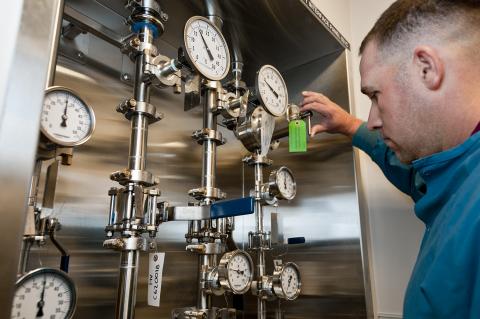
Troy Taylor adjusts the steam pressure on the manifold that provides pharmaceutical air, chilled water, steam, oxygen, and other gases to the bioreactors in PEL’s fermentation laboratory.
By Ashley DeVine, Staff Writer
John-Paul Denson and Troy Taylor of the Protein Expression Laboratory (PEL) used to pack liters of Escherichia coli lysates on ice, put them in the back of a microvan, and drive across campus to deliver the samples for protein purification.
Now that all PEL staff members are working under the same roof at the Advanced Technology Research Facility (ATRF), transferring samples is just a walk down the hall. Staff members were previously spread out in five buildings across the Fort Detrick campus.
Improved Fermentation Space for Protein Production
PEL’s fermentation laboratory is where all bacterial and yeast protein production work begins.
At the Fort Detrick location, the fermentation laboratory was packed with equipment, and hundreds of feet of wiring snaked along the floor to deliver utilities like water, steam, and pharmaceutical air to fermenters. If a fermentation needed oxygen, “we had to roll in a canister of oxygen on a cart, strap it down, and hook it up manually,” said Denson, a research associate in PEL’s Protein Purification Group.
At the ATRF, the hook-ups for utilities drop down from the ceiling into large manifolds, which connect to the fermenters. Adjustments are quick and nothing clutters the floor.
These quick adjustments are important because proteins produced from bacteria are sensitive to changes in temperature or oxygen levels. If temperatures are too high, protein yields could decrease. Likewise, a small change in dissolved oxygen could affect a project’s success. Reproducible protein production is vital because PEL often starts with smaller-scale production and then scales up to full production.
Although the fermentation laboratory’s space at the ATRF is similar in size to its previous space, the ceilings are higher (12 feet instead of seven) and the lab is set up to accommodate work flow.
Desk space is separate from the lab, giving researchers more space to monitor the bacteria and yeast fermentations that lead to protein production.
The Latest in Viral Suite Technology
PEL’s Viral Technology Group produces viruses from clones generated by the Cloning Group.
Before the move, PEL’s viral suites were in two different buildings, and some of the space was shared with other groups. DNA samples had to be hand-carried across campus from the molecular biology laboratories to the viral suites, where viruses were made.
With viral suites now in one location, PEL researchers are working in space that is customized for lentiviruses and adenoviruses. Adenoviruses require specialized containment because they are highly concentrated and can contaminate other viruses. Therefore, the viral suites are isolated, with separate access to a central autoclave.
“Lentiviruses and adenoviruses are innovative tools for understanding cancer pathways in cell lines or living animals,” said Dominic Esposito, Ph.D., director of PEL. A lentivirus stably transfers its DNA into the genome of a cell line to express proteins or introduce DNA to report on cellular activities. An adenovirus does not integrate its DNA, but instead delivers it to the cells to produce proteins transiently.
Improved Collaboration among PEL Staff
What began as an informal hallway discussion among group leaders led to a major improvement in PEL’s protein production process—the development of the Purify First technology for microscale protein purification. This technology allows PEL to monitor, at a smaller scale, the conditions (such as expression hosts or fusion tags) for protein purification that will allow a project to succeed when it is scaled up. Checking the conditions at a smaller scale provides a cost savings to customers.
Now all PEL staff members (and other ATP scientists) can come together for these types of discussions, likely paving the way for new advances.

